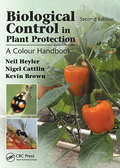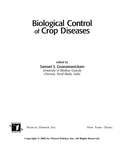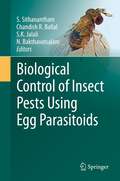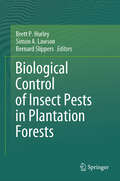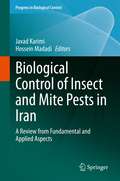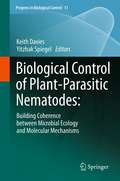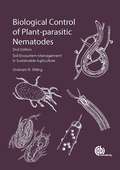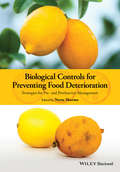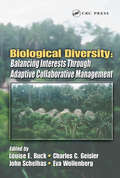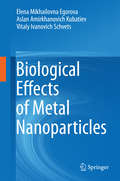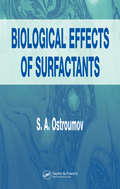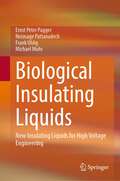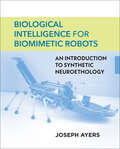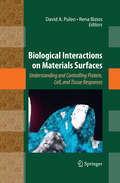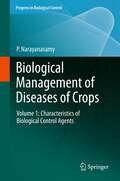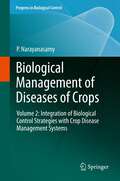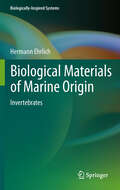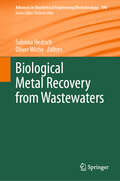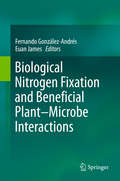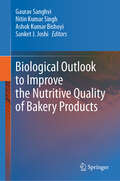- Table View
- List View
Biological Control in Plant Protection: A Colour Handbook, Second Edition
by Neil Helyer Nigel D. Cattlin Kevin C. BrownThere has been a large increase in the commercial use of integrated crop/pest management methods for pest and disease control on a wide range of crops throughout the world since the first edition of this book. The completely revised second edition of the bestselling Biological Control in Plant Protection: A Color Handbook continues the objective of
Biological Control of Crop Diseases
by Samuel S. GnanamanickamWith contributions from more than 30 internationally renowned experts, this book combines coverage of theory with coverage of global practices. Highlighting the day-to-day challenges of organic crop management for cost-effective real-world application, the book explores the biological control of diseases in 12 major crops. It focuses on the use of host plant resistance through transgenics and induced systemic resistance as a part of biological control. Topics covered include the role of biocontrol agents for signalling resistance, effective ecofriendly alternative to combat bacterial, fungal, and viral infestation, and transgenic crops in disease management.
Biological Control of Insect Pests Using Egg Parasitoids
by N Bakthavatsalam S. K. Jalali S. Sithanantham Chandish R. BallalThe theme of the book is highly relevant to the current emphasis on environment conservation, with focus on native biodiversity conservation in agro-ecosystems. The current impetus being given to organic farming and export oriented agri-hortculture in the country calls for access to relevant scientific knowledge base among the stakeholders. Research on biological pest control is more than a century old in India. Egg parasitoids, which are mainly tiny wasps, led by the family Trichogrammatidae, are the most widely utilized natural enemies for biological control globally. Over thirty countries are using these bioagents to protect over 10 million hectares of agricultural and forestry crops from many important insect pests. The book comprises 18 chapters, which are arranged in continuum, commencing with basic aspects of knowledge and ending in their utilization targets. The chapters cover broadly four areas: bio-diversity and natural occurrence of egg parasitoids, behaviour and adaptation of egg parasitoids, mass production and safe use of egg parasitoids and utilisation of egg parasitoids in different crop ecosystems. Some of the chapters cater to the needs of discipline-wise update on the current R&D scenario-like insect taxonomy, biotechnology, mass-production and quality control of the target organisms - egg-parasitoids, which are useful for laboratory scientists/researchers. There are also chapters devoted to knowledge status and scope for utilization of egg parasitoids in different target crops, which cater to requirements of field entomologists and extensionists for use in their tasks of guiding farmers/local guides. The book is different in approach, method, structure and content and ensures holistic coverage of the topic. The chapters are written by active and experienced workers in different crops and aspects and co-edited by four very experienced experts who have over three decades R&D experience in the subject. All the authors have uniformly focussed on comprehensive literature study and critical identification of knowledge gaps for future R&D, thus the book is novel in outlook, up-to-date in content and comprehensive in coverage of themes. This book will be useful for supplementary reading for MSc Agriculture and PhD Agriculture students, besides MSc/PhD research students in Zoology/Environmental Biology, who are specialising in Entomology. It would also serve as a very useful reference book for researchers worldwide, though focus is also there on Indian work. It addresses the special information needs of students and faculty, besides practitioners and extensionists in the Australasia and Africa regions and thus not limited to the R&D knowledge generated in developed countries.
Biological Control of Insect Pests in Plantation Forests
by Bernard Slippers Brett P. Hurley Simon A. LawsonThis book includes chapters focusing on the principles of biological control and influence of policy, ecology and diversity in establishing successful programs. Plantation forests have a crucial role to meet the fiber demands of a growing world population, especially considering the concerning decrease in the world’s total forest area. One of the greatest threats to the sustainability of plantation forestry is insect pests. Among the approaches that can be used to manage populations of insect pests, biological control is considered one of the most feasible and effective approaches to use in plantation forests. The authors review past and current major biological control programs in different plantation forest systems, including pine, eucalyptus and poplar, and including classical, conservation and augmentative approaches. Other chapters examine opportunities to use new technologies and integrated approaches and identify future challenges in the use of biological control.
Biological Control of Insect and Mite Pests in Iran: A Review from Fundamental and Applied Aspects (Progress in Biological Control #18)
by Javad Karimi Hossein MadadiThe book provides a reference to biological control of arthropod pests in agriculture and of public health importance in Iran. A quick glance over the literature shows a long history of biocontrol attempts in the country. Some historically important events highlighting the interest of Iranian academic, research and extension fields to the natural enemies and their applied aspects are provided. Iran, with an exception of the former USSR, was a pioneer in both basic and applied biocontrol in West Asia. The book consists of four parts: three parts for predators, parasitoids and pathogens, and last part for other approaches and analyses of the current state of biological control in Iran. The book provides the most up-to-date information on pest control and related topics of entomology in Iran. The chapters are written by scholars from major Universities and research centers in Iran.
Biological Control of Plant-Parasitic Nematodes: Building Coherence between Microbial Ecology and Molecular Mechanisms (Progress in Biological Control #11)
by Yitzhak Spiegel Keith DaviesThe offered volume intends to review the biological control theme of phytonematodes from several prospects: ecological; applicative as well as commercial state of the art; understanding the mode-of-action of various biocontrol systems; interaction between the plant host, nematodes' surface and microorganism's; candidates for biocontrol; extrapolation of the wide knowledge existed in another systems for understanding biocontrol processes: C. elegans as a model and lessons from other natural systems; and exploiting advanced genomic tools to promote understanding biocontrol processes and thereafter improve specific biological control agents.
Biological Control of Plant-parasitic Nematodes
by Graham StirlingPlant-parasitic nematodes are one of multiple causes of soil-related sub-optimal crop performance. This book integrates soil health and sustainable agriculture with nematode ecology and suppressive services provided by the soil food web to provide holistic solutions. Biological control is an important component of all nematode management programmes, and with a particular focus on integrated soil biology management, this book describes tools available to farmers to enhance the activity of natural enemies, and utilize soil biological processes to reduce losses from nematodes.
Biological Control of Plant-parasitic Nematodes: Soil Ecosystem Management in Sustainable Agriculture
by Graham StirlingPlant-parasitic nematodes are one of multiple causes of soil-related sub-optimal crop performance. This book integrates soil health and sustainable agriculture with nematode ecology and suppressive services provided by the soil food web to provide holistic solutions. Biological control is an important component of all nematode management programmes, and with a particular focus on integrated soil biology management, this book describes tools available to farmers to enhance the activity of natural enemies, and utilize soil biological processes to reduce losses from nematodes.
Biological Control: Case Studies from Around the World
by Charles Vincent Mark S. Goettel George LazarovitsBiological control, the management of pests by the use of living organisms, has a long history of application to agriculture around the world. However, the effective use of beneficial organisms is constrained by environmental, legal, and economic restrictions, forcing researchers to adopt increasingly multi-disciplinary techniques in order to deploy successful biological control programs. It is this complex process, including the mindset and the social environment of the researcher as well as the science being pursued, that this book seeks to capture. Chapters reveal the experiences of scientists from the initial search for suitable control agents, to their release into ecosystems and finally to the beneficial outcomes which demonstrate the great success of biological control across diverse agro-ecosystems. Drawing together historical perspectives and approaches used in the development of biological control as well as outlining current debates surrounding terminology and differential techniques, Biological Control: A Global Perspective will be a valuable resource.
Biological Controls for Preventing Food Deterioration: Strategies for Pre- and Postharvest Management
by Neeta SharmaVarious biotic factors cause diseases in crops, which result in food losses. Historically pesticide development has been instructive to us in terms of the benefits derived as well as the hazards that accompany their indiscriminate use. The application of fertilizers and pesticides to crops has become a norm in agricultural production, but this has led to resurgence in pests as they have developed resistance to such chemicals. Biological control of plant pests and pathogens is part of the solution to this problem. This is an area that continues to inspire research and development. It is also the foundation on which sustainable, non-polluting pest control for tomorrow’s farms must be built. Biological Controls for Preventing FoodDeterioration provides readers with options of non-chemical, eco-friendly, environmentally safe natural alternatives to prevent food from spoilage at pre- and postharvest stages. It covers the principles behind these techniques and their implementation. By integrating theory and practice, this book discusses the potential and associated problems in the development of non-chemical alternatives to protect food and addresses the common hurdles that need to be overcome to enable commercialization and registration of natural products for combating diseases. Focussing on plant foods, this timely book is unique in scope as it offers an international perspective on food deterioration caused by bacterial, fungal, viral, and mycotoxin contamination. It brings together highly respected scientists from differingyet complementary disciplines in one unified work that is important reading for food safety professionals, researchers and students.
Biological Diversity: Balancing Interests Through Adaptive Collaborative Management
by John Schelhas Eva Wollenberg Louise E. Buck Charles C. GeislerWe live in a world of wide pendulum swings regarding management policies for protected areas, particularly as they affect the involvement of local people in management. Such swings can be polarizing and halt on-the-ground progress. There is a need to find ways to protect biodiversity while creating common ground and building management capacity thr
Biological Effects of Fibrous and Particulate Substances (Current Topics in Environmental Health and Preventive Medicine #0)
by Takemi Otsuki Yasuo Yoshioka Andrij HolianThis volume examines our current understanding of the biological effects of fibrous and particulate substances, including discussions on nanoparticles. It offers comprehensive information on the latest insights into the immunological effects of various irritants on the human body. Readers will benefit from the contributing authors' diverse perspectives and extensive discussions of key issues, which include molecular alterations of the immune system and autoimmune diseases in connection with asbestos and silica, among others. The chapters also discuss recommendations, practical methods, and nanosafety science in situations involving exposure to nanotoxic substances. Edited in collaboration with the Japanese Society for Hygiene, this book provides up-to-date information on the immunological effects of nanotoxic substances to researchers interested in environmental and occupational health. Presenting a number of recent concepts and findings in the field, it enables readers to gain a comprehensive knowledge of health problems caused by environmental fibrous and particulate substances.
Biological Effects of Metal Nanoparticles
by Elena Mikhailovna Egorova Aslan Amirkhanovich Kubatiev Vitaly Ivanovich SchvetsThisbook offers a comprehensive overview of recent studies conducted on thebiological effects of metal nanoparticles. It also provides a solid theoreticalfoundation and various metal nanoparticle synthesis methods. PartI reviews the main chemical methods used for synthesizing metal nanoparticlesin a solution and describes original method of biochemical synthesis, as wellas some special procedures developed specifically for studying the biologicalactivity of nanoparticles. PartII analyzes current literature on the effects of metal nanoparticles observedin microorganisms and addresses the influence of silver nanoparticles obtainedby biochemical synthesis on biological objects on various organization levels,namely on microorganisms, acellular slimmold, unicellular alga, plant seeds andmammalian cells. Thelast section explains the central problems common in studies on the biologicaleffects of metal nanoparticles and outlines potential uses of this trend inbio-nanotechnologies. Thisbook is aimed at specialists, professors and students aspiring to expand theirknowledge about the biological activities of metal nanoparticles andnanoparticle-containing materials.
Biological Effects of Surfactants
by S.A. OstroumovOffering a new perspective on the hazards of pollution, Biological Effects of Surfactants examines the effects of anionic, non-ionic, cationic surfactants, and detergents on a wide range of organisms, populations, communities, and ecosystems. The author establishes new quantitative characteristics of the effects and presents study results on newly discovered phenomena. While proposing and substantiating new priorities and approaches for testing, assessing, and characterizing the biological activities and hazards of substances, the book illustrates how the data obtained can be used to develop effective environmental remediation and protection measures to improve water quality.
Biological Functions for Information and Communication Technologies: Theory and Inspiration (Studies in Computational Intelligence #320)
by Hidefumi SawaiBy incorporating biologically-inspired functions into ICT, various types of new-generation information and communication systems can be created. Just some example of areas already benefiting from such design inspiration are network architectures, information processing, molecular communication, and complex network modeling for solving real world-problems. This book provides the theoretical basis for understanding these developments and explains their practical applications. Highlighted inserts appears throughout to help readers to understand the very latest topics in these emerging research fields. The book ends with a more philosophical discussion on how new ICT solutions can be found by looking at analogous systems in biology. This new way of thinking may help researchers and practitioners to apply innovative ideas in developing next-generation technologies.
Biological Insulating Liquids: New Insulating Liquids for High Voltage Engineering
by Frank Uhlig Ernst Peter Pagger Norasage Pattanadech Michael MuhrThis book describes the state-of-the-art use of biological insulating liquids in detail. In recent years, more and more transformers filled with esters have been put into operation. This is because people recognize the benefits of ester liquids in terms of their fire safety (high flash and fire points) and environmental characteristics, judging from their biodegradability, their low CO2 footprint (only valid for natural ester) and their beneficial interactions with solid insulation, etc. One of the main reasons is that the water adsorption and absorption characteristics of these liquids are excellent and very different compared to mineral oil. The today’s discussion about climate change and global warming is an additional driver for using natural ester. Another advantage is that transformers filled with biological insulating liquids can operate with an overload of up to 150%. This is advantageous in the case of volatile energy generation from wind and solar power and in the supply of electrical energy for electromobility. Liquid inside electrical equipment is the lifeblood that serves both as a dielectric and a cooling medium. Some properties of these liquids differ from mineral oil, which had to be considered in the transformer design. The dielectric liquid is always in direct contact with transformer materials; therefore, the interaction should be very well understood, especially when retrofilling an existing mineral oil filled device. There are several natural ester fluids derived from various seeds and fruits on the market, and their properties may differ more or less. In the book, the most important properties of the different biological insulating fluids and mineral oil are compared. Ester fluids have already found their way into various standards. The condition of the device can be verified very well from the contents of the insulating liquids. For analysis and testing, the same equipment and devices that are commonly used for mineral oil are used for ester liquid. The chemical and physical behaviors of ester fluids compared to mineral oil are different. This must always be considered when interpreting test results stemming from ester fluids. The book is a guideline for students, original equipment manufacturers, users, laboratories and authorities in the use of biological insulating liquids.
Biological Intelligence for Biomimetic Robots: An Introduction to Synthetic Neuroethology
by Joseph AyersAn introduction to how neuroethology can inform the development of robots controlled by synaptic networks instead of algorithms, from a pioneer in biorobotics.The trait most fundamental to the evolution of animals is the capability to adapt to novel circumstances in unpredictable environments. Recent advances in biomimetics have made it feasible to construct robots modeled on such unsupervised autonomous behavior, and animal models provide a library of existence proofs. Filling an important gap in the field, this introductory textbook illuminates how neurobiological principles can inform the development of robots that are controlled by synaptic networks, as opposed to algorithms. Joseph Ayers provides a comprehensive overview of the sensory and motor systems of a variety of model biological systems and shows how their behaviors may be implemented in artificial systems, such as biomimetic robots. Introduces the concept of biological intelligence as applied to robots, building a strategy for autonomy based on the neuroethology of simple animal modelsProvides a mechanistic physiological framework for the control of innate behaviorIllustrates how biomimetic vehicles can be operated in the field persistently and adaptivelyDeveloped by a pioneer in biorobotics with decades of teaching experienceProven in the classroom Suitable for professionals and researchers as well as undergraduate and graduate students in cognitive science and computer science
Biological Interactions on Materials Surfaces: Understanding and Controlling Protein, Cell, and Tissue Responses
by Rena Bizios David A. PuleoSuccess or failure of biomaterials, whether tissue engineered constructs, joint and dental implants, vascular grafts, or heart valves, depends on molecular-level events that determine subsequent responses of cells and tissues. This book presents the latest developments and state-of-the-art knowledge regarding protein, cell, and tissue interactions with both conventional and nanophase materials. Insight into these biomaterial surface interactions will play a critical role in further developments in fields such as tissue engineering, regenerative medicine, and biocompatibility of implanted materials and devices. With chapters written by leaders in their respective fields, this compendium will be the authoritative source of information for scientists, engineers, and medical researchers seeking not only to understand but also to control tissue-biomaterial interactions.
Biological Magnetic Materials and Applications
by Tadashi Matsunaga Tsuyoshi Tanaka David KisailusThis book addresses the biologically controlled synthesis of magnetic materials, and its applications in bio-inspired design and synthesis. It highlights several key aspects of biologically produced magnetic materials – (i) organisms that biologically synthesize and utilize magnetic materials; (ii) formation mechanisms; (iii) how these biological formation routes yield various phases and morphologies; and (iv) the resultant magnetic and structural properties – and describes diverse bio-inspired approaches to utilizing magnetic materials in applications ranging from semiconductor to health industries.In addition, the book discusses the recent industrial use of magnetic materials to develop scalable technologies that encompass protein displays, drug-delivery, biophysical separations, and medical diagnostics, as well as outlining future next-generation applications. As such, it offers valuable insights for all scientists interested in using multidisciplinary fields to overcome current obstacles, and in gaining multifaceted expertise in magnetic materials bionanotechnology.
Biological Management of Diseases of Crops: Volume 1: Characteristics of Biological Control Agents (Progress in Biological Control #15)
by P. NarayanasamyBiological disease management tactics have emerged as potential alternative to chemical application for containing crop diseases. Biotic and abiotic biological control agents (BCAs) have been demonstrated to be effective against diseases caused by microbial plant pathogens. Combination of biotic and abiotic agents leads to synergism and consequent improvement in the effectiveness of disease control. It is essential to assay the biocontrol potential of all isolates/species of fungal, bacterial and viral biocontrol agents by different techniques in vitro and under greenhouse and field conditions and to precisely identify and differentiate the most effective isolates from less effective ones by employing biological, immunological and nucleic acid-based assays.
Biological Management of Diseases of Crops: Volume 2: Integration of Biological Control Strategies with Crop Disease Management Systems (Progress in Biological Control #16)
by P. NarayanasamyBiological management of diseases of crops is influenced by the nature of interactions between the pathogens and other organisms and the plants. Due to development of resistance in pathogens to fungicides and bactericides, determination of compatibility of biotic biocontrol agents with chemicals is essential for selecting strains of biocontrol agents (BCAs) showing resistance to chemicals to effectively restrict use of the chemicals. Microbial plant pathogens and the antagonists present in the soil and on the plant surfaces are influenced by various cultural practices. It is possible to reduce disease incidence and intensity by crop sanitation and using appropriate rotational crops. Application of physical techniques involving the use of heat, solarization and irradiation has potential to reduce the pathogen population or weaken the potential of pathogens present in the seed, planting materials and soil.
Biological Materials of Marine Origin: Invertebrates (Biologically-Inspired Systems #1)
by Hermann EhrlichBiological substances appeared in marine environments at the dawn of evolution. At that moment, the ?rst organisms acquired the ability to synthesize polymer chains which were the basis, in their turn, for the formation of the building blocks that fueled the so-called self-assembling process. They, in their turn, produced more complicated structures. The phenomenon of three main organic structural and sc- folding polymers (chitin, cellulose, and collagen) probably determined the further development and evolution of bioorganic structures and, of course, the organisms themselves. Allthethreebiopolymers,notwithstandingtheirdifferencesinchemical composition, have the common principles in their organization: nano?brils with the diameter 1. 5–2 nm, the ability to self-assemble, production of ?brillar and ?ber-like structures with hierarchical organization from nano—up to macrolevels, the ability to perform both the role of scaffolds and the templates for biomineralization and formation of the rigid skeletal structures. Chitin and collagen in particular played the determining role in the formation of skeletal structure in marine invertebrate organisms. These two biopolymers possess all the qualities needed to refer to them simul- neously as biological materials and biomaterials, the latter thanks to their successful application in biomedicine. The fact that modern science ?nds chitin and collagen both in unicellular and in multicellular invertebrates in fossil and modern species con?rms beyond a doubt the success of these biological materials in the evolution of biological species during millions of years. I realize that this success should be consolidated at genetic level and the detection of corresponding conserved genes must be the main priority.
Biological Metal Recovery from Wastewaters (Advances in Biochemical Engineering/Biotechnology #190)
by Sabrina Hedrich Oliver WicheThis book reviews the latest research on innovative and sustainable biotechnologies for metal recovery from various process streams, emphasising the fundamentals and applications of biosystems. Divided into 7 chapters, it clarifies many topics including biological iron and aluminum recovery from wastewaters, precious metal recovery (Pt, Pd, Au, Ag), algal-based metal recovery, selenium and tellurium recovery, phytoextraction options, and arsenic removal by sulfate-reducing bacteria. Expert contributors explore microbial metabolisms such as iron oxidation, sulfate/sulfur reduction, and selenite reduction through the lens of environmental sustainability. In this book, readers will discover various case studies and commercial applications of these biotechnologies. Particular attention is given to combinations of biological systems with electrochemistry to enhance metal recycling from complex and diluted streams. This book is a valuable resource for researchers in the field of environmental biotechnology, and scholars of environmental science, chemical engineering and microbiology. Waste management and resource recovery professionals will benefit greatly from the insights provided. This book is a must-read for anyone interested in sustainable solutions for critical metal supply within a circular economy framework.
Biological Nitrogen Fixation and Beneficial Plant-Microbe Interaction
by Fernando González-Andrés Euan JamesThis book covers the most recent advances in all the topics with which researchers and professionals need to be familiar in order to obtain a better understanding of, and to better exploit, beneficial plant-microbe interactions. The use of microorganisms for agriculture and environmental applications is gaining importance worldwide to improve crop performance, but also for other environmental applications, such as bioremediation in chemically polluted soils. The search for an equilibrium between fundamental and applied aspects makes this book useful for professionals at various levels in the value chain of the "microbial biofertilizers". Challenges of comercializing biofertilizers involve efficiency of the products and safety for human health and the environment, topics that have paid central attention in this book. Students, scientists and biofertilizers developers will find updated and comprehensive information about the different aspects to be considered to address a successful introduction of biofertilizers in sustainable agriculture and environmental actions.
Biological Outlook to Improve the Nutritive Quality of Bakery Products
by Nitin Kumar Singh Sanket J. Joshi Gaurav Sanghvi Ashok Kumar BishoyiThis book aims to bring the focus on biological viewpoint and alternatives for producing the baked goods, as the confectionary is a major market segment comprising of the sugar and baked products. The bakery products include major segments including cereals, bread, chocolates, cookies, and other confectionary items. This book provides the data regarding the market of baked goods, as it is forecasted to increase at growth rate of 5.8% (CAGR) and it’s expected to reach around its growth around (7%) by 2025 (Fortune insights 2022). The book also classifies amongst the major consumers worldwide, Asia pacific contributes around 43%, western Europe contributes around 22% while Africa continent represents as smallest group of consumers for baked confectionary consumers. The book provides information regarding health concerns as baked goods are liked by population of all ages. As per the data mentioned above the bakery goods are consumed heavily without clear insights about its health concerns. Majority of baked goods are made up of all-purpose flour having serious risk concerns/impact on health and higher consumption of bakery goods can increase sugar, cholesterol level and can also cause further problem in liver or heart functions. Although, gluten free, multigrain baked confectionaries are now a day’s available in the market but the still the better understanding of the bio-based products is need of current time. The biological viewpoint especially for the bakery goods can serve as initial point for better handling baked goods in context of upbringing of healthy society. The book targets students and researchers interested in interdisciplinary research and devising novel biological applications with special focus on bakery products.
